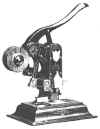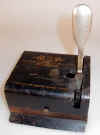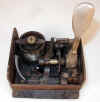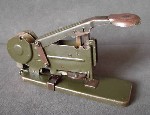Early Office Museum
Antique Stapler Gallery
~ Spool Stapling Machines ~
Spool stapling machines inserted and clinched staples they made from coils of steel or brass wire, with the exception of the Eveready, which used a coil of steel tape.
The first office stapling machine that used a spool of wire was advertised in 1881. This is pictured immediately below.
|
Model, Year, Maker |
Click Image to Enlarge |
Automatic Wire
Stitching Machine
Patented 1880-82 ~ Advertised 1881-82
Snider & Hoole, Cincinnati, OH
Hasbrouck & Watson, then W. H. Hasbrouck, New York, NY
Replaced by a heavier model in 1883, which was advertised 1883-90.
We are not aware of any surviving example of these machines. |
 |
Greenfield Automatic Fastener (top photo to right)
Advertised 1894
Greenfield Automatic Fastener Co.
New York, NY
The Greenfield Automatic Fastener, which made 1,200 staples from a coil of wire, was sold only briefly.
In 1895, the Jones Manufacturing Co. was identified as the successor to the Greenfield Automatic Fastening Co. In 1895 Jones introduced the Greenfield Automatic Pin-Tag Machine (bottom image to right). A pin-tag is a tag that is fastened with a pin or staple to a garment in a retail clothing store. The base of the Pin-Tag machine was similar in design to the base of the Jones Star Paper Fastener (see Strip Stapling Machines) but larger. |

 |
Ever Ready Stapler (subsequently
Eveready
Stapler)
Patented 1915-24 ~ Advertised 1915-42
Ever-Ready Fastener Co., Boston, MA
Eveready Mfg. Co of Boston, Boston, MA
The Eveready made 5,000 staples from a coil of steel tape. There were several similar models. |

 |
Spool O Wire Fastener
Patented 1917-21 ~ Advertised 1915-36
Hutchison Office Specialties Co., New York, NY (1915-22)
(As of 1917, "Built for us by the Remington Typewriter Co.")
Remington Typewriter Co., Ilion, NY (1927)
Remington Rand (1928)
The Victor Safe & Equipment Co, Marietta, OH (1928-36)
This machine made 15,000 staples from a coil of steel wire.
 |

 |
McGill's Fastener
Regd 850190
U. K.
Photo courtesy of Ken Craite |
 |
Bates Stapler
Model A: Patented 1931 ~ Marketed 1930-31 ~ Advertised 1930-31
Models B, C, and D: Patented 1933-40 ~ Advertised 1931-68
The Bates Mfg. Co., Orange, NJ
According to a January 1931 company statement, “The
original model of the stapler came into possession of the Bates firm four
years ago, but was not satisfactory. The company’s engineers went to
work on it and four totally different models were prepared in the next
three years, each better than the last. The fourth model was tried out
under actual working conditions, but certain imperfections were found, and
the product went back to the engineering department for study. In the
summer of 1929 the final model was turned out and tested until early in
1930, when distribution began in [a] limited territory. Now the staplers are
being offered all over the country.” The “original model” to
which reference is made in the preceding quotation is explained in U.S.
Patents No. 1,610,632, Dec. 14, 1926, and No. 1,637,357, Aug. 2, 1927,
both issued to Sven Svenson, Fond du Lac, WI. Svenson’s original
application, which was filed in 1924, was based on a design that was
substantially different from the Bates machine that was marketed in 1930.
Later in 1931, Bates introduced Model B. According to a product
description, “There are three basic and important improvements in this
new model stapler. The base and the body are more heavily reinforced, the
new patented refill can be quickly and easily inserted, with all separate
parts eliminated, and last, the new wire refill is tangle proof and it is
impossible for the wire to become snarled or loosened. From now on, orders
for Bates staplers will be filled with the new model B. The new model B
refill…will not fit the old Model A stapler.” (Sept. 1931)
Styling changes were made during the 1930s. Machines made during
1930-35, including Model A and Model B, have round knobs and
open sides so that you can see the vertical spring. Machines made from 1935
onward, including Model B, C, and D, have rectangular "knobs" and
closed sides.
Model B was $5.00 in 1936. Model C was $6.50 in 1950, $7.00 in 1955, and $7.95 in 1961. Model A, B, and C machines made 5,000 staples from a spool. A lower capacity Model D was introduced in 1941 at $3.50 but was not on the market for long. |
 Bates Stapler Model A, 1930-31 Bates Stapler Model A, 1930-31
 Bates Stapler Model B, 1931-35 Bates Stapler Model B, 1931-35
 Bates Stapler Model C, sold through 1968 Bates Stapler Model C, sold through 1968
 Bates Stapler Model B, c. 1940. Courtesy of Ken Craite. Bates Stapler Model B, c. 1940. Courtesy of Ken Craite.
|
Delta Stapler
Advertised 1936
Delta Maschinen Gesellschaft
Bonn, Germany |

|
Bates Electric Stapler
Advertised 1951-68
The Bates Mfg. Co.
Orange, NJ
By 1958, this was called the Model C electric stapler.
Bates manual and electric Model C staplers both used the B-50 wire spool that appears in the photo of the manual Model C stapler above.
|
 |
Bates Automatic Electric Stapler Models EB50 & EBD52
Advertised 1959
The Bates Mfg. Co., Orange, NJ
The EB50 stapler used the same roll of brass wire used by the manual Bates Models B & C and the Electric Model C discussed above.
The EBD52 used two rolls and inserted two staples with a distance of up to 4" between centers.
In 1959, Bates introduced an electric stapler with two interchangeable heads, one for wire and one for standard staples; we do not have an image.
|
 |
Return to Top of this Page
|














